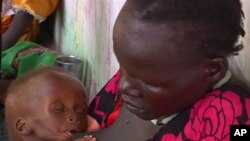The United Nations warned Thursday that parts of South Sudan face imminent famine unless urgent action is taken to get food aid to people in need.
The warning, released jointly by UNICEF, the World Food Program (WFP) and the Food and Agriculture Organization (FAO), came after the Integrated Food Security Phase Classification (IPC) released a report saying 3.9 million people in South Sudan are severely food insecure.
Of those, 30,000 in Unity state are classified by the IPC as facing catastrophic levels of hunger. The IPC assessment is the first to find that a section of the population of South Sudan is at the highest level of food insecurity.
"There is a concrete risk of famine occurring between October and December 2015 if urgent humanitarian access and assistance is not provided in the most affected areas," the IPC report says.
The IPC lists the areas on the brink of famine as Leer, Guit, Koch and Mayendit counties in Unity State, and parts of Jonglei and Upper Nile states. South Sudan's 22-month conflict has been centered on those three states, but particularly on oil-producing Unity and Upper Nile.
No aid for 22 months
UNICEF's Vilma Tyler told South Sudan in Focus that some villages in Unity and Upper Nile states have been cut off from receiving aid, or even assessment visits from humanitarian workers, for nearly two years.
There is a concrete risk of famine occurring between October and December 2015 if urgent humanitarian access and assistance is not provided in the most affected areas.Integrated Food Security Phase Classification (IPC)
She said people have lost their sources of income, and, often, their hope for the future.
Children have been particularly hard hit by the crisis in South Sudan, Tyler said. Many of the children that UNICEF has seen are "... malnourished, children are sick, children have been traumatized. They haven’t been able to go to school. These children have lost everything.”
Inflation, market disruption
WFP regional spokeswoman Challiss McDonough said even people who live in areas that have not been drawn into the 22 months of conflict face hunger.
“Food insecurity in those areas has been driven by very high inflation rates, market disruption, the economic crisis, large scale displacement related to the conflict; loss of livestock and agricultural production. The situation is serious everywhere,” she said.
McDonough said South Sudanese will need sustained assistance over the next year, at least.
Serge Tissot, the head of the Food and Agriculture Organization (FAO) in South Sudan, said predictions of below-average cereal production in neighboring Uganda, Sudan and Ethiopia will only make the food crisis in South Sudan worse.
In spite of having fertile soil and a climate favorable to numerous crops, South Sudan imports almost all of the food its people eat. Since the country plunged into conflict in December 2013, the poor economy has been compounded by a sharp drop in oil production -- the main revenue source for the government -- and an unfavorable exchange rate for the U.S. dollar, which is used to purchase imports.






